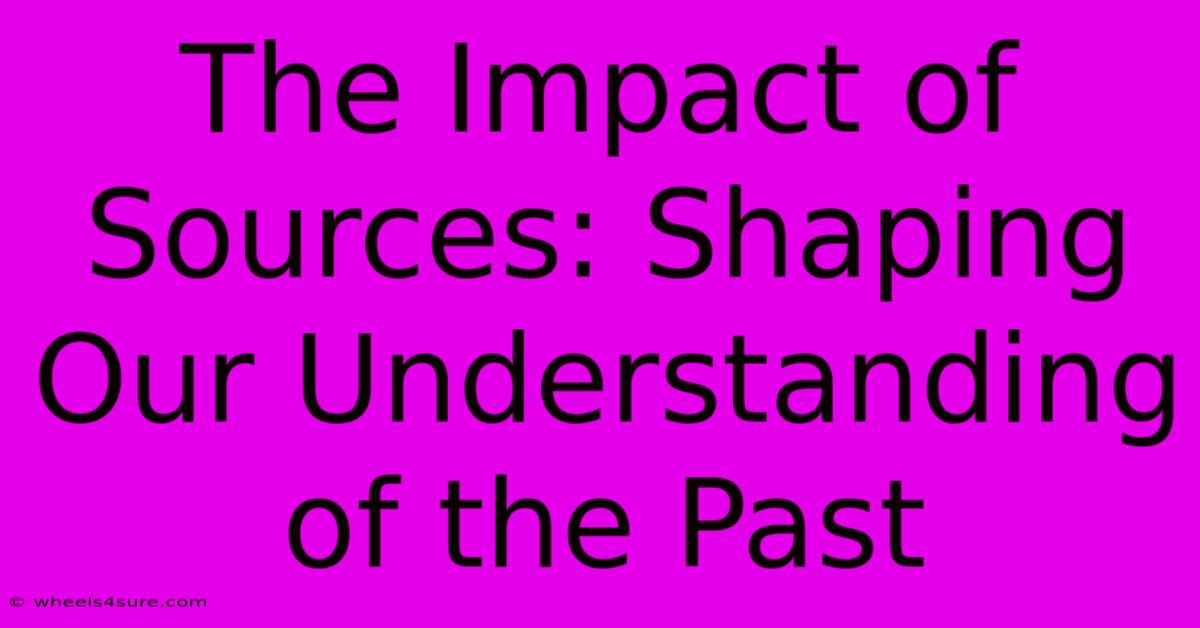The Impact Of Sources: Shaping Our Understanding Of The Past

Table of Contents
The Impact of Sources: Shaping Our Understanding of the Past
History isn't simply a collection of facts; it's a narrative constructed from the fragments of the past. These fragments, our historical sources, are the raw materials historians use to understand and interpret events. However, the nature of these sources – their type, origin, and biases – profoundly impacts how we perceive the past. Understanding this impact is crucial to developing a nuanced and accurate understanding of history.
The Diverse Landscape of Historical Sources
Historical sources come in many forms, each offering a unique perspective and posing its own challenges:
Primary Sources: Eyewitness Accounts and Artifacts
Primary sources are materials created during the time period being studied. These offer firsthand accounts and insights, but their inherent biases must be carefully considered. Examples include:
- Written Documents: Letters, diaries, government records, legal documents, and literary works all provide valuable information, yet they reflect the author's perspective and potential biases. A king's account of a battle, for instance, will likely differ from that of a peasant soldier.
- Artifacts: Objects like tools, clothing, pottery, and buildings offer tangible evidence of past lives and cultures. Archaeological findings, while silent, can reveal much about daily life and societal structures. However, their interpretation often relies on contextual clues and expert analysis.
- Oral Histories: Recorded interviews with individuals who lived through historical events offer valuable perspectives, though memory can be unreliable and influenced by time and perspective.
Secondary Sources: Interpretations and Analyses
Secondary sources are interpretations and analyses of primary sources. They are created after the event being studied and offer a crucial layer of understanding. Examples include:
- Scholarly Articles and Books: Historians analyze primary sources, synthesize information, and offer interpretations of the past. These works are vital for understanding diverse perspectives and ongoing historical debates.
- Biographies and Memoirs: While offering valuable insights into individual lives, biographies are inherently subjective and shaped by the author's perspective and the available evidence.
- Documentaries and Films: These media present historical events in a visually compelling way, but their narrative choices and potential biases must be critically examined.
The Significance of Source Criticism
Source criticism, also known as historical criticism, is the process of carefully evaluating sources to determine their authenticity, reliability, and potential biases. This crucial skill allows historians to:
- Identify Bias: Understanding the author's background, motivations, and potential biases is essential for interpreting the information presented.
- Assess Authenticity: Determining whether a source is genuine and hasn't been altered or fabricated is crucial for establishing its trustworthiness.
- Evaluate Reliability: Assessing the accuracy and consistency of the information presented in the source is vital for constructing a reliable historical narrative.
- Consider Context: Understanding the social, political, and economic context in which a source was created provides valuable insights into its meaning and significance.
The Evolution of Historical Understanding
Our understanding of the past is not static; it evolves as new sources are discovered and as existing sources are re-evaluated in light of new perspectives. This constant reassessment highlights the dynamic nature of historical inquiry. For example, the discovery of new archaeological evidence or the re-examination of old documents can significantly alter our understanding of past events and societies.
Conclusion: A Critical Approach to the Past
The impact of sources on our understanding of the past cannot be overstated. By critically analyzing the diverse range of sources available, acknowledging their limitations, and considering different perspectives, we can construct a more nuanced, accurate, and comprehensive understanding of the human experience. A critical engagement with historical sources is not merely a methodological requirement; it is essential for a responsible and insightful exploration of the past. Only through careful evaluation can we truly grapple with the complexities and ambiguities that shape our understanding of history.

Thank you for visiting our website wich cover about The Impact Of Sources: Shaping Our Understanding Of The Past. We hope the information provided has been useful to you. Feel free to contact us if you have any questions or need further assistance. See you next time and dont miss to bookmark.
Featured Posts
-
Lady Gagas Net Worth More Than Just A Pretty Face
Apr 12, 2025
-
How Jurnee Smollett Makes And Spends Her Millions
Apr 12, 2025
-
Valtteri Bottas Net Worth And Career Highlights
Apr 12, 2025
-
Learn The Secrets To Building Wealth Like Scarlett Johansson
Apr 12, 2025
-
Daughter In Bengali A Cultural And Historical Journey
Apr 12, 2025
